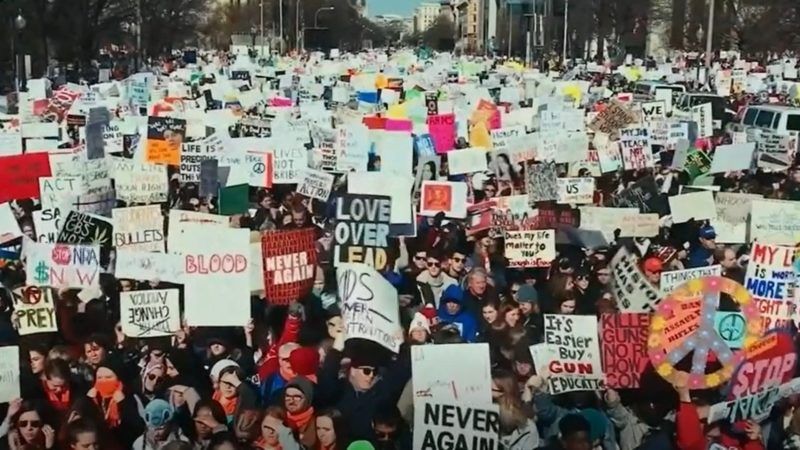Are the Democrats Right That We Are Seeing an 'Epidemic of Gun Violence'?
The rhetoric may not be accurate, but it is definitely useful.

Criticism of President Donald Trump's response to the COVID-19 epidemic has figured prominently at the Democratic National Convention this week. But last night the party shifted its focus to a different sort of epidemic.
The actress Kerry Washington, the evening's M.C., introduced the topic at the beginning of the program, saying "90 percent of Americans support common-sense gun laws, because we need to do more to address the epidemic of gun violence." A convention video continued the theme. "Long before this pandemic, our country has been suffering from an epidemic of gun violence," a Florida gun control supporter identified as "Maria W." says, describing murder by firearm as a "public health crisis."
Democratic presidential nominee Joe Biden uses similar rhetoric. "Joe Biden knows that gun violence is a public health epidemic," his campaign website says, introducing "The Biden Plan to End Our Gun Violence Epidemic." This year's Democratic platform likewise talks about "ending the epidemic of gun violence."
Leaving aside the question of whether the "common-sense gun laws" Biden favors would actually have a meaningful impact, is it accurate to describe gun violence in the United States as an "epidemic"? Obviously not in any literal sense, since gun violence is not caused by an infectious microorganism that spreads from person to person. Figuratively, however, the term epidemic implies a problem that is escalating and out of control, which is true of gun violence only if you focus on a narrow slice of the data.
According to the FBI's numbers, total homicides in the United States fell from 24,700 in 1991 to a low of 14,164 in 2014—a 43 percent drop. The homicide rate fell even more dramatically, from 9.8 per 100,000 in 1991 to 4.4 per 100,000 in 2014—a 55 percent drop. Homicides rose in 2015 and 2016, then fell in 2017 and 2018, when the rate was 5 per 100,000, up 14 percent from 2014. The FBI has not published final data for 2019 yet, but preliminary numbers for the first half of the year indicate that homicides fell by 7.4 percent.
The trends for murders committed with firearms are slightly different because the type of weapon used varies over time. Gun homicides fell from a peak of 17,075 in 1993 to a low of 7,803 in 2014—a 54 percent drop. The number rose in 2015, 2016, and 2017, then fell in 2018, when it was 32 percent higher than in 2014 but still 40 percent lower than the 1993 total. The gun homicide rate in 2018 was about 3.1 per 100,000, half the 1993 rate.
As Philip Bump noted in The Washington Post last year, most Americans are not aware of this dramatic decline in gun homicides. In a 2019 Marist poll, 59 percent of respondents believed "the per capita gun murder rate in the U.S." was higher than it was 25 years earlier, while 23 percent thought it was "about the same." Just 12 percent knew that the rate had fallen, while 6 percent were not sure.
That misperception probably has a lot to do with news coverage of mass public shootings, which account for less than 1 percent of gun homicides. But all the talk about a gun violence "epidemic" reinforces the false impression that we are seeing historically high levels of murders committed with firearms.
The Democrats might argue that three consecutive years of rising gun homicides (followed by a drop) constitute an epidemic, even if the rate remains historically low. But they were already talking about an "epidemic" of gun violence in 2016, when the most recent FBI data indicated no trend that could justify that description even by the most generous definition.
Exaggerating a problem is a time-honored technique to build support for the policies you favor. It creates a sense of urgency that encourages voters to overlook those policies' shortcomings, such as the irrelevance of "assault weapon" bans and the inability of "universal background checks" to affect the gun sources that criminals typically use.
At the same time, describing gun violence as an epidemic—the same framing that has generated myriad dubious studies of this criminological topic in medical and public health journals—applies a pseudoscientific veneer to proposals whose merits depend on value judgments as well as uncertain predictions about the practical consequences of "common-sense" gun controls. Such rhetoric also slants the debate by suggesting that deadly violence is a disease that can best be controlled by attacking the vectors of transmission—i.e., guns and bullets. It may not be accurate to talk about gun violence this way, but it is definitely useful.


Show Comments (189)